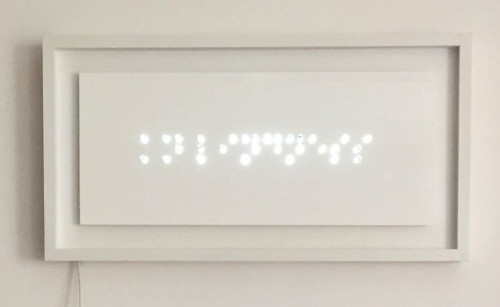Il titolo dell’opera è costituito dalla parola inglese blindness, cecità, scritta in Braille, il sistema di scrittura tattile usato da persone non vedenti o ipovedenti.
L’opera, che presenta quella stessa parola realizzata con luci LED, costituisce una riflessione sulla cecità, intesa come insensibilità, indifferenza, spesso ostilità, con le quali la società tratta ed esclude le minoranze di ogni sorta: persone portatrici di minorità fisiche o psichiche, inclinazioni, comportamenti, modi di pensare ‘diversi’. Tale esclusione impoverisce la società, rendendola letteralmente ignorante di ogni ‘essere altrimenti’ e l’ignoranza del diverso genera superficialità, stupidità, razzismo e ogni genere di mostruosità.
L’opera intende pertanto criticare l’identificazione tradizionale tra ‘normale’ e ‘buono’, la presunzione degli inclusi di avere l’esclusività del corretto intendimento e comportamento. I non vedenti, che qui rappresentano gli esclusi, possono decifrare l’opera, leggendone il titolo e toccandola, al contrario i vedenti, cioè gli inclusi, possono farlo solo ricorrendo all’ausilio di una spiegazione.
‘Avere luce negli occhi’ non significa capire. Non si tratta qui di echeggiare l’espressione del Piccolo Principe, ‘l’essenziale è invisibile agli occhi’, quanto di evidenziare che l’essenziale è visibile a chi è capace di vedere guidato dalla luce della ragione e non invece a chi è soltanto capace di guardare con la luce degli occhi, ma senza capire, accecato dal pensiero unico dominante come da un’intensa sorgente luminosa.
——————————————–
The title of the work consists of the word ‘blindness’, written in Braille, the tactile writing system used by people who are blind or visually impaired.
The work, which presents that same word made with LED lights, is a reflection on blindness, understood as callousness, indifference, often even hostility, with which the ‘society’ traits and excludes the minorities of all sorts: people with physical or mental minorities, ‘different’ inclinations, attitudes, ways of thinking. Such exclusion impoverishes the society, it makes it literally ignorant of each ‘be otherwise’ and the ignorance of the different generates superficiality, stupidity, racism and all sorts of monstrosities.
Therefore, the work intends to criticize the traditional identification between ‘normal’ and ‘good’, the presumption of the included people to be the only ones who are capable of correct understanding and behavior. The blind people, who here represent the excluded ones, can decipher the work, by reading its title and touching the work itself, on the contrary the seeing people, the included ones, can only do it by means of an explanation. ‘To have light in the eyes’ does not mean to understand.
The work does not intend to echo the expression of the Little Prince, ‘what is essential is invisible to the eye’, instead, it aims to highlight that what is essential is visible to those who are capable of seeing guided by the light of reason and not to those who are only able to look with their eyes, but without understanding, blinded by the dominant single thought, as by an intense light source.
Ugo Piccioni, Spoleto 2016
“OPUS & LIGHT”, MADONNA del POZZO / Porta Monterone, SPOLETO, 21 maggio – 19 giugno 2016.
Progetto: STUDIO A’87, in collaborazione con Palazzo Collicola Arti Visive e con il patrocinio dell’Assessorato alla Cultura del Comune di Spoleto.
UGO PICCIONI ‘BLINDNESS’ scritta in Braille, 2016
Inaugurazione: Porta Monterone, 5 SPOLETO, sabato 21 maggio 2016 ore 17:30.
Installazione visibile ad orario continuato, giorno e notte.
Data e Ora
21/05/2016 / Tutto il giorno
Luogo
Chiesa Madonna del Pozzo Porta Monterone


